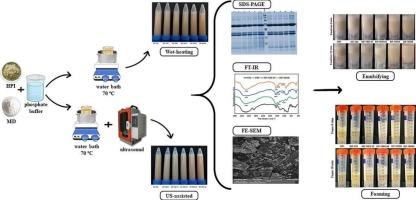Ultrasound-intensified wet-heating induced Maillard reaction between hemp cake protein and maltodextrin: Structural characterisation, techno-functional and antioxidant properties
IF 9.7
1区 化学
Q1 ACOUSTICS
引用次数: 0
Abstract
In this research, hemp protein isolate (HPI) was obtained from hemp cake using isoelectric precipitation and conjugated with maltodextrin through the Maillard reaction using wet-heating alone and combined with ultrasound to enhance its structural, functional properties (including solubility, emulsifying, foaming properties and water/oil holding capcity), and antioxidant properties. Covalent bonds between HPI and maltodextrin were confirmed using methods like SDS-PAGE, FTIR, XRD, fluorescence spectroscopy, secondary structure analysis, amino acid profile, and glycation degree (DG) measurement. Ultrasound significantly accelerated glycation, reaching a DG of 25.06 % in just 60 min, while reducing melanoidin formation, whereas wet-heating required 24 h to achieve a similar level of DG. Structural analysis revealed that wet-heating resulted in greater structural modifications due to its longer reaction time. These changes included a decrease in α-helix and β-sheet structures, higher surface hydrophobicity and zeta potential, and more noticeable microstructural changes. Techno-functional assessments revealed that wet-heating conjugates exhibited superior solubility (up to 95.77 %), emulsifying (emulsion stability index up to 48.67 %), and foaming (foaming capacity up to 107.14 %) properties, and antioxidant properties (71.95 % of ABTS), compared to ultrasound-assisted conjugates. This study highlights how ultrasound can intensify the wet-heating glycation of proteins to modify their structure, consequently improving their techno-functional properties to provide a novel plant-based protein ingredient for various food applications.

超声强化湿加热诱导麻饼蛋白与麦芽糖糊精之间的美拉德反应:结构表征、工艺功能和抗氧化性能
本研究采用等电沉淀法从麻饼中分离得到大麻分离蛋白(HPI),并通过美拉德反应与麦芽糖糊精进行单湿加热和超声结合,以提高其结构、功能性能(包括溶解度、乳化性、起泡性和持水/油能力)和抗氧化性能。采用SDS-PAGE、FTIR、XRD、荧光光谱、二级结构分析、氨基酸谱、糖基化度(DG)测定等方法对HPI与麦芽糊精之间的共价键进行了确证。超声显著加速糖基化,在60分钟内达到25.06%的DG,同时减少了类黑素的形成,而湿加热需要24小时才能达到相似的DG水平。结构分析表明,由于湿加热反应时间较长,导致结构变化较大。这些变化包括α-螺旋和β-片状结构的减少,表面疏水性和zeta电位的提高,以及更明显的微观结构变化。技术功能评估显示,与超声辅助的偶联物相比,湿加热偶联物具有更好的溶解性(高达95.77%)、乳化性(乳液稳定性指数高达48.67%)、起泡性(起泡容量高达107.14%)和抗氧化性(ABTS的71.95%)。这项研究强调了超声波如何加强蛋白质的湿加热糖基化以改变其结构,从而改善其技术功能特性,为各种食品应用提供一种新的植物性蛋白质成分。
本文章由计算机程序翻译,如有差异,请以英文原文为准。
求助全文
约1分钟内获得全文
求助全文
来源期刊

Ultrasonics Sonochemistry
化学-化学综合
CiteScore
15.80
自引率
11.90%
发文量
361
审稿时长
59 days
期刊介绍:
Ultrasonics Sonochemistry stands as a premier international journal dedicated to the publication of high-quality research articles primarily focusing on chemical reactions and reactors induced by ultrasonic waves, known as sonochemistry. Beyond chemical reactions, the journal also welcomes contributions related to cavitation-induced events and processing, including sonoluminescence, and the transformation of materials on chemical, physical, and biological levels.
Since its inception in 1994, Ultrasonics Sonochemistry has consistently maintained a top ranking in the "Acoustics" category, reflecting its esteemed reputation in the field. The journal publishes exceptional papers covering various areas of ultrasonics and sonochemistry. Its contributions are highly regarded by both academia and industry stakeholders, demonstrating its relevance and impact in advancing research and innovation.
 求助内容:
求助内容: 应助结果提醒方式:
应助结果提醒方式:


